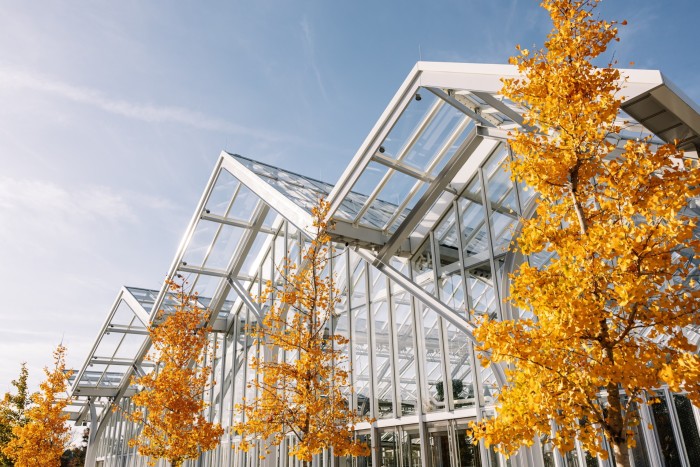Longwood Gardens’ spectacular reinvention

Commentators are struggling to reimagine post-election America. All the while the country’s greatest temple of horticulture has been reimagining itself. I have just enjoyed a preview of the new centrepiece at Longwood Gardens, Philadelphia County, before its public opening this weekend. It has been based on plans laid 14 years ago and on four years of active installation. It centres on a massive new glasshouse that covers 32,000 sq ft and houses 17,000 plants. It shows US design, energy and co-ordination at its best.
The pillared facade and interior of Longwood’s old central conservatory above the gardens’ terrace are a hard act to follow. The fountains in the court below soar to 130ft and dance at night in a multicoloured ballet. The buildings house great displays of orchids and beautifully matched indoor plants in a changing sequence throughout the year, culminating in the displays for Christmas. Many of you might have imagined visiting them one day, but you now have to rethink what you will see.
The central conservatory’s new wing is designed to protect three floating islands of plants with a Mediterranean theme. This huge glasshouse is billed as a living, breathing building whose roof opens and shuts for ventilation like the gills on a giant fish. Standing inside its soaring glass, I gasped.
Longwood’s gardens extend over land bought by the businessman and philanthropist Pierre du Pont, beginning in 1906. They are underpinned by his legacy, enabling the gardens’ board to embark on projects whose scale no British garden could contemplate. The new West Conservatory has cost $250mn. Well done, Longwood: it is one thing to have masses of money but quite another to spend it beautifully. Longwood gardens are devoted to beauty, horticulture, education and delight. Hundreds of thousands of mini lights shine at Christmas in its shrubs and trees. Pear and vodka cocktails preface dinners in the 1906 restaurant overlooking the fountain court. Drabbies have not had an input.

Thank heavens the new glasshouse is not yet another giant dome. It has no tower clapped on to it and it could not look less like a carbuncle. The architects, Marion Weiss and Michael Manfredi, explained to me their integration of a crystalline ridge and a pleated glass roof supported by branching columns.
Nearby, the Cascade Garden conceived by the late Brazilian maestro Roberto Burle Marx, his one garden in North America, was cramped in its original position, but under supervision from Burle Marx’s expert pupils it has been enlarged with new stone and families of appropriate plants. It leads on to new buildings and courtyards planted with fine trees. I was intrigued by the choices.
The space leading to the glasshouse is planted with 22 ginkgo trees, already colouring a vivid autumn yellow. In Oxford I planted a second ginkgo in 1999 to match a widely spreading one by our college entrance that sheds stinking fruit in late autumn. It disgusts those who have to walk by it, but I defend it as a female tree, exemplifying nature’s reproduction. At Longwood the ginkgos are biloba Princeton Sentry, upright, neat and male, without smelly fruits.
Beside the new conservatory, 28 elm trees link the space to open landscape beyond. What about the killer elm beetle, I wondered, but the trees are Accolade elms, Ulmus davidiana x japonica Morton, propagated from resistant stock at the Morton Arboretum west of Chicago. The choice has been carefully assessed and may be worth copying in Britain. Ten Japanese cherries then punctuate a court displaying bonsai trees. More than 50 are gifts from the nearby Kennett Collection, holders of the finest bonsai collection in North America. Kimura Masahiko, known as the “magician”, is one of the Japanese masters who has shaped them.

The cherries are Yoshino cherries, Prunus yedoensis, that may one day confuse historians. The same variety has been used recently by the Royal Horticultural Society for the reimagined entry court of Wisley Gardens. Longwood’s choice, I learnt, was unrelated and I doubt if theirs was in the Wisley planters’ minds, either. Coincidences happen.
In his welcome speech, Paul Redman, chief executive of Longwood Gardens since 2006, promised “new reciprocities of wonder and discovery”. I believe him, as he has already propelled a remarkable extension of Longwood’s grounds, features and ambitions. The indoor orchid court was reimagined in 2022. The six water lily ponds, home to 1,200 plants, will be reopening with a new design next spring.
The world’s finest fountains have been totally overhauled and newly choreographed: what Versailles’ fountains are to the feeble ones at London’s Marble Arch, Longwood’s are to those at Versailles. How Louis XIV would tax and spend if he could see what he now needs to compete against.

Du Pont’s fortunes were partly based on gunpowder. Even so, he was motivated at home by conservation and charity. He began his holdings at Longwood by buying a farm in order to save its historic trees, which were otherwise to be felled and sold as timber. The gardens now include a wild-flower meadow of 86 acres, burnt each spring, that opens up trails through flowers, butterflies and insects. A farm of 505 acres has just been added to the gardens’ holdings. It will be fascinating to see how Longwood develops it.
How do they heat and water their huge new glasshouse? Of course they are ahead of mutterings about extravagance and sustainability. The heating is derived geothermally from 128 deep boreholes and piping in the ground. All the rain water, up to a million gallons a year, will be preserved from roof run off and reused. The planting is designed round plants from dry habitats, a lesson for our future, jazzed up by frequently changing decorative displays.


The range evokes Mediterranean ecology, but visitors from that inland sea between Gibraltar and the west coast of Turkey will find Ceanothus Yankee Point from California, minty prostanthera from Australia and many species from South Africa or Mexico. They evoke what scientists know as the Mediterranean eco-zone, one much wider than the Mediterranean itself. There are a few Italian cypresses, but no grey-leaved ballota, not even a silvery olive tree. They were excluded because they were found to harbour insects. Big blue-grey Bismarck palms stand in for them, from Madagascar, however, not the Med.
The planting flows in streams and is spectacular. As the climate dries and warms, it will be an instructive solace for the future. This weekend Longwood’s Christmas displays open too, a solace for the next two months. From their yearly designer, Jim Sutton, I have had advance knowledge of this year’s theme: magic. If the weather becomes grey and wet after Christmas, dump unmagical Britain and go to the gardens whose spell is intended to lift our mood.
Robin Lane Fox travelled as a guest of Longwood Gardens
Find out about our latest stories first — follow @ft_houseandhome on Instagram
#Longwood #Gardens #spectacular #reinvention



